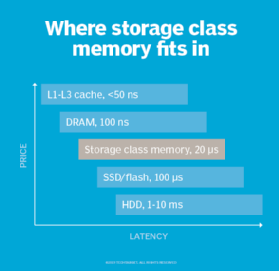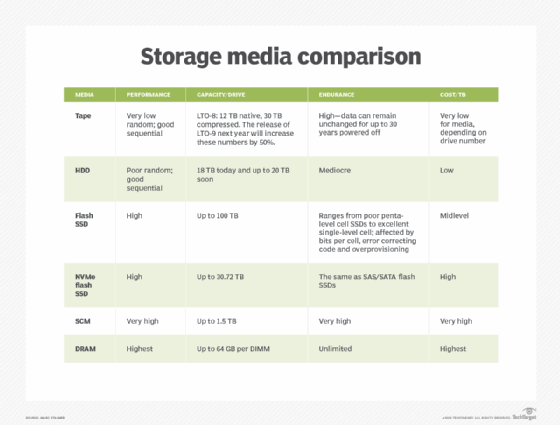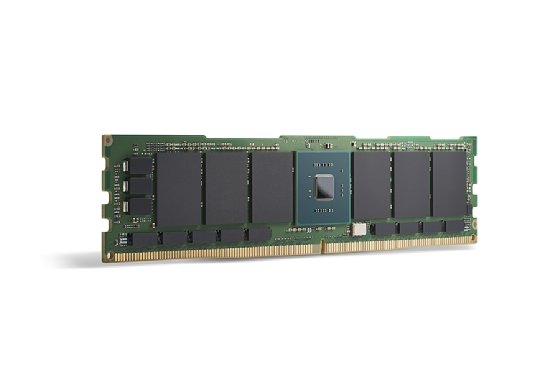storage class memory (SCM)
What is storage class memory?
Storage class memory (SCM) is a type of physical computer memory that combines dynamic random access memory (DRAM), NAND flash memory and a power source for data persistence. SCM treats non-volatile memory as DRAM and includes it in the server's memory space.
Access to data is faster than access to data in local, PCIe-connected solid-state drives (SSDs), direct-attached hard disk drives (HDDs) and external storage arrays. SCM is more durable than DRAM, and it can read and write data as much as 10 times faster than NAND drives.
SCM hardware uses different media types to solve capacity, cost, endurance and performance issues.

SCM's importance in data centers
The data center can benefit in several ways from storage class memory, including the following:
- High-performance storage. SCM can enable high-performance storage workloads in support of digital transformation.
- Persistent storage. The onboard power source ensures data and program code are retained during a system crash or power failure. This provides a byte-addressable tier of persistent storage between DRAM and SSDs. Using SCM extends fast DRAM performance to stateful storage. It provides a way to attach PCIe-based drives via the non-volatile memory express (NVMe) protocol for low-latency
- Block-level data access. It also supports block-level data access, which broadens the range of applications it can support.
- Less processing, more throughput. With SCM, less data needs to be shuttled between memory and storage. This reduces processing and increases throughput. An SCM device can log speeds nearly as fast as DRAM and static RAM (SRAM). Depending on the workload, the combination of persistence and speed allows SCM devices to be used either as memory or storage.
Volatile vs. non-volatile memory
The main distinction between volatile memory and non-volatile memory is volatile memory does not keep data when the power goes out. Non-volatile memory does hold on to data in a power outage or system crash.
Here's a closer look at the two memory types:
Volatile memory
DRAM and synchronous DRAM (SDRAM) store volatile data. This type of data seldom changes once it is written to storage. Information that applications and programs need to start up personal computers (PCs) is an example of volatile data. DRAM is faster than flash, but it is more expensive and has limited scalability.
Non-volatile memory
Non-volatile memory, also called persistent memory, permanently stores regularly accessed data. This type of data includes boot files and other operating system (OS) data that execute functions of a PC.
Non-volatile RAM (NVRAM) resides on the PCIe bus. NVRAM devices typically have a backup battery or capacitor to ensure data persistence.
Flash storage is the most common type of NVRAM. Compared to DRAM, flash can handle large amounts of data. Unlike DRAM, which is internal to a computer, flash is an external media often contained in a networked storage array. All-flash arrays have no disk and generally perform better than disk-based storage.
The cost of SSDs has dropped and is approaching parity with HDDs, removing cost as a barrier to flash adoption. But the downside to flash, relative to disk, is NAND flash wear-out. Over time, writes cause flash to degrade, affecting its endurance. To keep that from happening, storage vendors designed hybrid flash arrays that mix capacity HDDs and performance-oriented SSDs.
HDDs and SSDs vs. storage class memory
The form factor and deployment of SCM-based storage differs from that of HDDs and SSDs in the following ways:
- Hard disk drives. An HDD is an electromechanical device that uses magnetic media for data storage. The drive's media rotates rapidly on a spindle, and as it does, an actuator positions a needle over a given sector on the disk where data is written.
- Solid-state drives. An SSD is designed with silicon media and has no moving parts. SSDs initially were adapted to use the SATA and SAS storage protocols developed for HDDs. Manufacturers are now starting to produce SSDs designed for the NVMe specification for PCIe flash.
- Storage class memory. SCM cards slide into dual inline memory module (DIMM) server ports. SCM drives do not replace SSDs. Instead, they are an adjunct memory that boosts performance of latency-sensitive applications. Should the primary storage drives reach maximum capacity, SCM also can be set as a secondary write target.

SCM features and limitations
Enterprises can derive several benefits from using an SCM tier, including the following:
- Drives last longer than conventional flash ones.
- They enable DRAM-like access through system memory to large data sets in real time.
- The technology costs less than buying more DRAM.
- It offers lower access latencies and higher throughput than SSDs.
- It protects crucial data from being lost if power to enterprise storage is disrupted.
Despite those advantages, the average price of SCM drives is a drawback to broader adoption. Adding SCM can help reduce DRAM expenses, but an SCM drive may be 10 times more expensive than a similar NVMe configuration.
Wider adoption may result in commodity pricing. Meantime, organizations should do a cost-benefit analysis to determine if adding SCM will improve an application's productivity.
Enterprise use of SCM
SCM is important for high-speed data transfers, next-generation in-memory computing and scale-out clusters for computation and storage. An SCM tier might be useful for applications sensitive to downtime or that frequently access complex data workloads.
Modern applications that use AI and machine learning algorithms can benefit from SCM's high-speed access to server memory. These applications need constant access to massive sets of data, but buying more DRAM to provide that access is costly.
In some instances, SCM can be used to replace DRAM, albeit at slightly slower speeds. As a DRAM replacement, SCM provides benefits such as fast database-server restarts during maintenance, power emergencies and reboots.
Various operational applications and databases can make use of SCM, especially those that need low-latency, durability and data consistency. The technology has the potential to speed up virtual machine storage. It also can help multinode, distributed-cloud applications perform better.
Enterprise use cases for SCM include:
- big data analytics to replace or augment a hot or warm data cache;
- cybersecurity analysis to detect and defend against ransomware and other threats;
- financial trading applications to rapidly process and execute financial transactions;
- fraud detection to perform data analytics to detect fraudulent transactions;
- in-memory databases that power online transaction processing software;
- internet of things (IoT) analytics to process large data sets in real time; and
- webscale personalization to tailor online content relevant to individual users.
Intel-Micron 3D XPoint memory
Intel and Micron jointly developed an SCM version called 3D XPoint, solid-state storage to bridge the performance gap between DRAM and NAND. AI, advanced analytics, databases, high-performance computing and virtualized infrastructure are among the anticipated uses.
Unlike conventional NAND, which uses a charge trap to hold information, 3D XPoint stores data bits based on the different resistance levels between the bulk material of a memory cell. The level of resistance determines a signal's binary value: if on, the binary value is 1; if off, the value is 0.
In 2018, Intel launched its first line of 3D XPoint-based products, branded Intel Optane. The development of Optane coincided with the rise of AI, IoT, gene sequencing, streaming media and similar demanding workloads.
Intel offers dual-ported Intel Optane SSDs and Optane Persistent Memory (PMem) modules. Optane PMem DIMM capacities range from 128 GB to 512 GB per module and fit systems that accommodate PCIe-based SSDs. When Intel Optane capacity is added to a system, the computer's OS enumerates the drives as NVMe storage devices.

Micron reportedly planned to launch a competing product to Intel Optane, but in March 2021 it decided to cease 3D XPoint development. Micron said it plans instead to sell its 3D XPoint chipmaking plant and shift development research to memory technologies engineered for the emerging Compute Express Link (CXL) standard. CXL connectivity enables the creation of shared pools of SCM by linking discrete CPUs, graphics processing units and similar acceleration chips.
It is not clear how Micron's decision will affect the future of Intel Optane product development. In June 2021, Intel discontinued its line of desktop Optane SSDs and announced it would focus on Optane Memory H2O M.2 SSDs. Optane H2O layers bulk QLC NAND behind an Optane memory cache.
Samsung Z-NAND and other SCM types
Samsung Z-NAND is made from flash media. It is a low-latency variation of its vertical NAND, or V-NAND, memory. Technically, it is not SCM, although it features performance gains that are close to those of 3D XPoint.
Z-NAND organizes 48 layers of Single-level cell flash with floating gate transistors to ensure each cell receives the correct voltage. Samsung uses Z-NAND memory for its Z-SSD product line.
Other types of SCM include the following:
- AMD, an Intel competitor, does not have a branded SCM technology. Instead, it pairs its EPYC-based accelerators with Western Digital Corp.'s Ultrastar DC ME200 Memory Extension Drives and a native hypervisor that maps NAND flash to host memory.
- Kioxia, formerly Toshiba Memory, is also developing SCM technology. It aims to boost parallelism with its XL-Flash SCM. XL-Flash is an extension of the Bit Cost Scalable 3D NAND flash technology first developed by Toshiba. Kioxia said it will offer XL-Flash in an SSD form factor, with eventual plans to make it available on the DRAM bus.
- Smart Modular Technologies markets a range of persistent memory modules built with its branded DuraMemory, which is geared for heavy industry and rugged environments.
SCM products
To date, Intel and Samsung are the only vendors shipping SCM drives. They are designed with their respective proprietary memory technologies. Intel offers its Optane product line and Samsung its Z-NAND. The two companies take different approaches to capturing data bits. Yet, they both position their memory technologies as high-performance data storage for in-memory databases and related dense, real-time workloads.
Now-defunct semiconductor company Diablo Technologies was an early SCM pioneer with its Memory1. SanDisk, now part of Western Digital, and IBM adopted Diablo's technology. The vendor filed for bankruptcy in 2017. That happened shortly after it won a patent infringement lawsuit brought by SCM competitor Netlist. Chipmaker Rambus in 2019 acquired Diablo's remaining intellectual property.
SCM's impact on storage array design
The advent of SCM, and Optane drives in particular, have changed how hardware manufacturers engineer servers and storage technologies. Several storage vendors deploy Intel Optane SCM tiers in their branded networked storage systems, including the following:
- Dell EMC adds Optane PMem as a performance tier on its flagship PowerMax SAN. Optane drives also are packaged with NVMe SSDs in the Dell EMC PowerStore midrange storage system.
- Hewlett Packard Enterprise (HPE) injects SCM-based enterprise memory flash technology in its midrange line of Nimble Storage SANs. HPE's Persistent Memory cards are branded Optane versions in certain HPE ProLiant servers or as optional add-in cards.
- Hitachi Vantara offers its Virtual Storage Platform 5000 Series arrays, which give users the option to configure a system with SCM that provides 100% of the cache capacity.
- Lenovo announced support for Intel Optane on some ThinkSystem servers.
- MemVerge, a 2017 startup, developed Memory Machine that virtualizes DRAM and Intel Optane to create a large persistent data lake, from which it serves replication, snapshots and other data services.
- NetApp designed Memory Accelerated Data software, also called Max Data, using the Plexistor memory technology NetApp acquired in 2017. Max Data-enabled systems also support Intel Optane SCM.
- Pure Storage combined NVMe flash and branded DirectMemory modules in its FlashArray//X all-flash array to enable a fast read cache. Pure's DirectMemory is based on dual-ported Intel Optane devices.
- StorOne has the All-Flash Array.next system, which packages Optane with Intel QLC 3D NAND and is managed by the S1 storage software.
- Vast Data deploys a large SCM write buffer with intelligent data placement to extend the longevity of its all-flash storage architecture.
Other non-volatile memory types
Other non-volatile memory media are emerging that could match or exceed the capacity and performance of traditional computer memory and flash storage. Notable technologies and the vendors developing them include these three technologies:
- Resistive RAM. Also known as ReRAM or RRAM, this is memory that varies resistance via a dielectric-based memristor. Switching resistance increases the amount of signal flowing in one direction, in proportion to decreased signal flow in the opposite direction. Fujitsu and Crossbar are the two leading producers of RRAM.
- Magnetoresistive RAM (MRAM). Everspin Technologies has developed MRAM that rather than using an electron charge exploits the magnetism spinning electrons generate to store persistent data. Everspin has developed, licensed and marketed several MRAM products, using its own semiconductor fabrication facility. These include Toggle MRAM and Spin-transfer Torque MRAM (STT-MRAM). In March 2021, the company launched a 1 Gb STT-MRAM device based on 28-nanometer processing and aimed at cloud infrastructure providers.
- Nanotube RAM (NRAM) Nantero's NRAM memory cells situate hundreds of carbon nanotubes between electrodes, which are used to switch the voltage. Changes in the cell's resistance correspond to its binary switching state.
The future of storage class memory
SCM provides a larger addressable memory space that can be set to operate in memory mode or as storage. Data placed in SCM travels a shorter I/O path and reduces garbage collection on large blocks of data.
Computational storage is a related technology that embeds processing chips directly in the storage subsystem. Data operations are performed as close as possible to the processor to speed up data analytics.
Computational storage systems can rapidly collect, analyze and process reams of real-time data generated in edge computing environments. Several vendors are developing proprietary data processing units (DPUs), the most notable of which is the Nvidia's Mellanox DPU.
For many organizations, choosing between computational storage and SCM media isn't an either/or decision. In the near term, the technologies are expected to coexist in enterprise data centers to address different targeted workloads.
Learn about recent updates to computational storage development and what the future of flash memory looks like.






